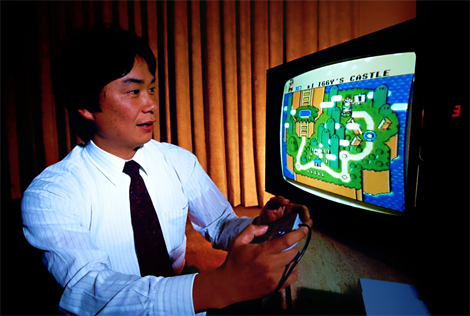Q. How and when did you get started in the videogame business?
A. I started working at Nintendo Company Ltd. in 1977 as a designer. At first I designed characters and artwork for arcade games. But in 1980, I directed the design and art work for Donkey Kong in which Mario first appeared.
Q. What were some of the things you thought about when you created Mario?
A. We had to work under technical constraints including the number of pixels and number of colors the Famicom can display. There are many reasons why we drew him the way we did. We gave him a mustache rather than a mouth because that showed up better. We gave him a hat rather than hair because that looked better, too. Mario wears overalls because that shows the movement of his arms, and he's wearing white gloves because the white contrasts better with the colored backgrounds. These are the technical reasons we made him look the way he does.
Q. So from there you decided to make him a plumber?
A. We wanted him to be a character that works very hard. Also, we wanted him to be shorter than enemy characters and the princesses he rescues. Based on these factors, we decided on his appearance. We always draw the dot character first, and from that, we make other artwork, for the package for example.
Q. What were your thoughts when you created Super Mario Bros.?
A. We developed programming techniques which allowed us to create a larger character than we originally thought possible. At first, we planned to make the game so that the player was always "big" Mario, but eventually, we came up with the idea for the Power-Up Mushroom to make him Super.
Q. How do you explain the number of changes in Mario's appearance over the years?
A. The main reason the character changed was because we have different artists and programmers working on the Mario series from game to game. Also, the hardware technology has become more advanced and hardware limitations are the most important factor in influencing what we can and can't do. Who knows how Mario will look in the future. Maybe he'll wear metallic clothes!
Q. Where do you get the ideas for the other Mario game characters?
A. We have a very large design staff working on the Mario games, and each member contributes ideas. The Koopa Kids, for example in Super Mario Bros. 3, were modeled after the design team of that game. This is another way we give recognition to the many people who help make the games successful.
Q. How do you go from a game idea to an actual program?
 |
| Miyamoto playing Super Mario World in 1992. |
A. Usually the design staff gives detailed ideas to the programmers in the form of rough sketches and written instructions. But because it's a team effort, we often sit down and discuss different points, sometimes late into the night. What most players don't know is that everything in a video game happens for a reason. Even a powerful system like the Super NES has many programming limitations. It's easy to say. "It would be better if you made such and such happen." Many times we probably think the same thing, but the idea just can't be done because of programming limitations.
Q. How many people does it take to make a Mario game?
A. It seems like every time we do a Mario game, four more people join the team. Sixteen people helped with Super Mario World, and it took us about three years to make.
Q. When you first created Mario, did you expect him to become as popular as he is?
A. We had no idea!
Q. Has the game of Mario changed your life? Do people ever recognize you on the street?
A. No one has ever recognized me, but I think that is because I look like an average kind of guy. Plus, the dedicated fans who might recognize me are probably at home playing video games!
Q. How do you decide when to make another Mario game?
A. After we finish a Mario game, the staff usually vows never to do another one! But once the game is released, we start thinking it may not be such a bad idea to add another title to the series. We usually have lots of ideas that we haven't been able to implement yet. A good example is Yoshi the dinosaur who just appeared in Super Mario World. We wanted to have Mario ride a dinosaur ever since we finished the original Super Mario Bros., but it was impossible technically. We were finally able to get Yoshi off the drawing boards with the Super NES.
Q. What's in the future for Mario?
A. I don't know if there will be another game in the Super Mario series, but I can say there is something special in the works.
Q. What is your on-going philosophy about making video games?
A. Challenge for the player is the most important thing. In the Mario games for example, the player can go back and try to finish the game without collecting a single coin. I think great video games are like favorite playgrounds, places you become attached to and go back to again and again. Wouldn't it be great to have a whole drawer full of "playgrounds" right at your fingertips?
|